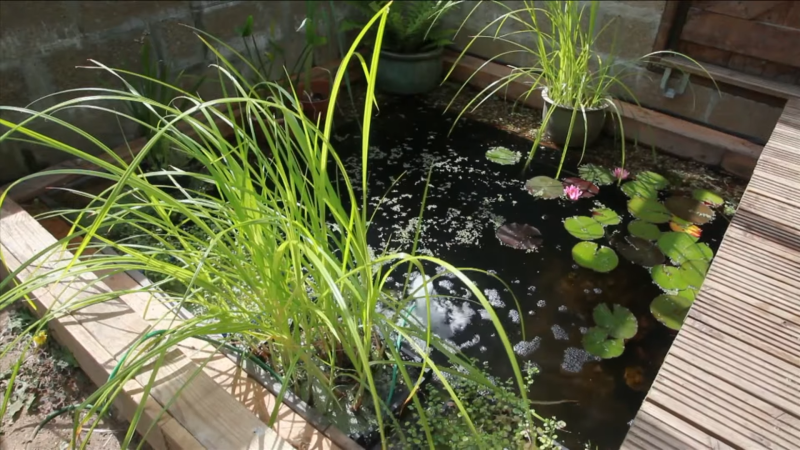When we think of swimming pools, we typically think of large fiberglass, plastic, or concrete constructions full of pristine, clear water. They’re usually maintained in this state with the regular addition of chlorine or other chemical. These kill biological stuff and help filter out dirt and other detritus. However, [David] likes to do things differently, as he demonstrates with a tiny plunge pool built inside his greenhouse.
The basic construction starts with digging a hole and building up a wall with concrete and bricks. There’s nothing particularly controversial there. It’s roughly 2 meters by 3 meters by 0.8 meters deep. To help the pool maintain heat, there’s a layer of foam insulation in the bottom, while the water is held inside a black liner.
Rather than traditional chemical methods, however, [David] relies on organic methods to maintain the pool. He explains how he uses an aquarium pump to create a “bubble filtered” pool that draws water through a gravel bed to maintain it and keep it clear. It’s a very natural setup, with multiple plants in the water to make it as organic as can be. It’s the kind of thing you’d expect to see at a luxury island resort, but [David’s] got one right in his very own greenhouse. [David] explains the organic filtering concept in greater detail on his website.
We’ve featured some pool hacks before, too, though more traditional ones than this. Video after the break.
[Thanks to Keith Olson for the tip!]

















Seems like a lot of work to avoid needing to treat them with chemical regularly. OTOH less problem for your skin if people are sensitive to chemical.
He could have installed a UV filtering device to avoid any chemicals. It works well enough to kill almost all algae and bacteria, but not insects/bugs. For those, a water pump is required to create water motion. It’s completely organic without the cons.
Does the destruction of all the bacteria affect the nitrogen cycle within the pond?
Depends on the filter setup, but generally no. The nitrifying bacteria in this case would mostly live in the substrate, so as long as you’re not creating too much flow in there they’ll be okay. There will be some losses, but it’s not too bad.
This is one of the common failures of the ill-defined term “organic.” I don’t think he wants UV lights
For things like this, the extra work is part of the pleasure.
Not that I have anything against swimming in water with plenty of other things living in it but if you’re not putting chemicals into it to keep biological stuff from setting up housekeeping in it, it’s a pond not a swimming pool.
The idea is to be a gardener and support certain biological stuff while weeding out others, not to have a sterile vat of water to sit in
without filtering out or killing the ameoba that act as hosts for Legionella pneumophila, I don’t think I’d want to splash in this little pool.
That’s not really much of a worry if you have a full ecosystem going on like you do outside. While pretty much any unchlorinated water has some amount of them around, Legionella bacteria mostly breed well indoors or in otherwise wet, divorced from nature environments. Beats me why, I never cared to find out more.
https://en.wikipedia.org/wiki/Legionnaires%27_disease#Prevention
Not sure if it would thrive in the conditions above.
Most natural swimming ponds are designed to keep the water chemistry inhospitable to dangerous microbes. That’s not to say it can’t happen but a well functioning pond shouldn’t have it.
Do you never set foot in any natural body of water? Your hypochondria will be worse for you in the long term, that isn’t without risks as well (and the risk of killer amoebas is pretty remote). Neurosis is also a life-stealing disease.
It’s a lovely pond !!
Add some goldfishes if you don’t want to turn your pool into a mosquito nursery.
Don’t forget to invite Carl!
https://www.youtube.com/watch?v=9tFNbncymjY
Another ordinary day in a third-world tropical country
That’s very cool. I’m always amazed at the volumes of water that bubble pumps can shift – especially when you consider the tiny amounts of power they need to do it.